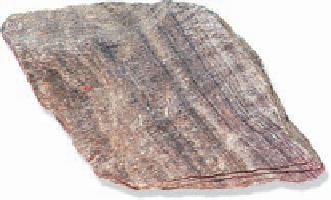Geology Reference
In-Depth Information
◗
Figure 7.12
Schist
◗
Figure 7.11
Phyllite Hand specimen of phyllite. Note the lustrous
sheen, as well as the bedding (upper left to lower right) at an angle
to the cleavage of the specimen.
by the partial melting of rock during intense metamorphism.
Such an origin is possible provided that the host rocks con-
tained quartz and feldspars and that water was present.
Not all geologists agree that migmatites necessarily form
from partial melting. Some argue that the characteristic
layering or wavy appearance arises by the redistribution of
minerals during recrystallization in the solid state—that is,
through purely metamorphic processes.
a
Almandine garnet crystals in a mica schist.
In some metamorphic rocks, the mineral grains do not
show a discernable preferred orientation. Instead, these
rocks consist of a mosaic of roughly equidimensional min-
erals and are characterized as having a
nonfoliated texture
(
◗
Figure 7.15). Most nonfoliated metamorphic rocks result
from contact or regional metamorphism of rocks with no
platy or elongate minerals. Frequently, the only indication
that a granular rock has been metamorphosed is the large
grain size resulting from recrystallization. Such rocks may
also have a sugary or shiny luster from the refl ection of light
from the many large crystal faces.
Nonfoliated metamorphic rocks are generally of two
types: those composed of mainly one mineral—for example,
marble or quartzite—and those in which the different min-
eral grains are too small to be seen without magnifi cation,
such as greenstone and hornfels.
Marble
is a well-known metamorphic rock composed
predominantly of calcite or dolomite; its grain size ranges
from fine to coarsely granular. Marble results from either
contact or regional metamorphism of limestones or dolo-
stones (
b
Hornblende-mica-garnet schist.
◗
Figure 7.16 and Table 7.1). Pure marble is snowy
white or bluish; however, many color varieties exist because
of the presence of mineral impurities in the original sedi-
mentary rock. The softness of marble, its uniform texture,
and its varying colors have made it the favorite rock of
builders and sculptors throughout history (see the Introduc-
tion and Geo-inSight on pages 180 and 181).
Quartzite
is a hard, compact rock typically formed
from quartz sandstone under intermediate- to high-grade
metamorphic conditions during contact or regional meta-
morphism (
◗
Figure 7.17). Because recrystallization is so
complete, metamorphic quartzite is of uniform strength
and therefore usually breaks across the component quartz
◗
Figure 7.13
Gneiss Gneiss is characterized by segregated bands
of light and dark minerals. This folded gneiss is exposed at Wawa,
Ontario, Canada.






Search WWH ::

Custom Search